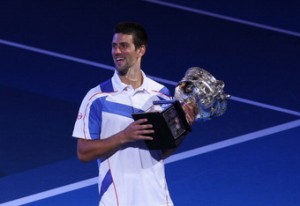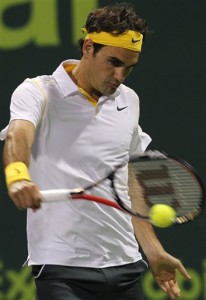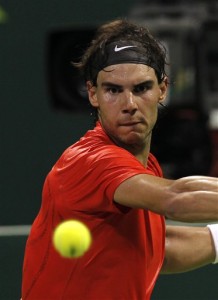A Reversal of Fortunes: Novak Djokovic Derailed Rafael Nadal
A year ago at the conclusion of the 2010 US Open, Rafael Nadal was king of the mountain, having just captured his first US Open trophy and a career grand slam.
He had 10,475 ATP ranking points, leading Roger Federer by 3,260 points, Novak Djokovic by 3, 810 and Andy Murray by 5,350 total points.
Life was good.
Things were definitely looking up for the world No. 1 who had just completed the best summer season of his life on the tennis court.
By the end of 2010 Nadal remained the top dog with 12,450 points leading world No. 2 Federer by 3,305 points, Djokovic by 6,205 points and No. 4 Murray by 6,690 points.
The two top-ranked players were separating themselves from the rest of the pack, and that included No. 3 Djokovic and No. 4 Murray. That meant the continuing Federer-Nadal iron grip at the top was going to be “the” tennis story of 2011.
Or was it?
Heading into the Australian Open, all eyes focused on Federer and Nadal, hoping to see the tennis giants make it through the draw to play each other in another epic final in five sets.
Nadal was poised to become the first man since Rod Laver in 1969 to hold all four grand slam titles at one time. Although not an official grand slam, because the wins were not completed in the same calendar year, it would become a “Rafa Slam.”
![]() A win in Melbourne afforded Nadal a once-in-a-lifetime chance to do something only one man in the modern era had previously accomplished. The world No. 1 was determined to fulfill his destiny.
A win in Melbourne afforded Nadal a once-in-a-lifetime chance to do something only one man in the modern era had previously accomplished. The world No. 1 was determined to fulfill his destiny.
As for Roger Federer, the Swiss had just dominated all players at the 2010 Barclay World Tour Finals in London, winning his fifth championship there. Many expected the world No. 2 to come back strong and win his seventeenth major at the Australian Open.
Ultimately, the 2011 Australian Open brought Nadal no glory after he sustained a hamstring injury during the second game in set one of his quarterfinal match against countryman David Ferrer. Nadal, unwilling to retire as he had in 2009 against Andy Murray, toughed it out, losing to Ferrer is straight sets 6-4, 6-2, 6-3.
Federer on the other hand lost to a very strong, unyielding Novak Djokovic in the semifinals of the Australian Open. It caused fans to recall Djokovic’s 2008 victory over Federer in the semifinals of the Australian Open, only this time Federer was not suffering from the lingering effects of mononucleosis.
This time it was a pure a simple beat-down by Djokovic over the world No. 2.
For Djokovic, it was now his time. His win over Federer at the 2010 US Open semifinals, after losing to the Swiss in 2008 and 2009 at that same stage of the tournament, showed Djokovic was on the brink.
![]() The impetus of his win over Federer during the 2011 Australian Open semifinals helped pushed the Serb over the top.
The impetus of his win over Federer during the 2011 Australian Open semifinals helped pushed the Serb over the top.
Djokovic finally understood he was as good as the two men at the top. After that, the Serb never looked back.
Djokovic went on to surpass Federer, becoming the new world No. 2 at the ATP Masters at Indian Wells. It marked the first time the Swiss was not ranked in the top two since 2004.
In fact, Djokovic did not lose a match in 2011 until Federer defeated him in the semifinals at the 2011 French Open.
In the meantime, Nadal lost five straight finals to Djokovic, including the men’s championship match at Wimbledon in July of 2011.
It also meant that in just a little over a year, Nadal lost his No. 1 ranking––a ranking that seemed utterly secure, even as late as January 1, 2011.
The ranking points melted away from the former world No. 1 as Djokovic began gathering the maximum at each and every tournament they met.
Nadal, however, faced Federer in the 2011 French Open final where the world No. 1 managed to retain his title––the one bright spot of the year.
![]() Currently Djokovic has amassed 13,290 points along with a 61-2 record. He leads world No. 2 Nadal by 1,870 points, No. 3 Federer by 4,901 and No. 4 Murray by 6,755 points. These numbers do not include US Open points that will be awarded at the conclusion of the 2011 tournament held at Flushing Meadows.
Currently Djokovic has amassed 13,290 points along with a 61-2 record. He leads world No. 2 Nadal by 1,870 points, No. 3 Federer by 4,901 and No. 4 Murray by 6,755 points. These numbers do not include US Open points that will be awarded at the conclusion of the 2011 tournament held at Flushing Meadows.
Starting with the 2011 US Open Djokovic will be defending 2,850 points until the end of the year. World No. 2 Nadal has 3,680 points to defend, Federer 3,930 points and Murray 1,805 points.
That means at the end of the US Open, if Djokovic wins, he will have 14,090 points while Nadal will fall to 10,620 points if he makes the final. Otherwise, their point count will not change should Nadal win with Djokovic once again the runner-up.
There is very little doubt but that Djokovic will end the year as the No. 1 ranked player in the world with as comfortable a lead as Nadal had one year ago.
But, as this year proves, change at the top can come in a heart beat.
The question remains––is Djokovic building another Federer-like dynasty, or is he just enjoying a John McEnroe-like year? In 1984, McEnroe compiled a 82-3, winning record, adding 13 singles titles to his tennis resume; but McEnroe fell quickly off the pinnacle in 1985, finally taking a leave from the tour in 1986.
![]() Roger Federer held the No. 1 ranking for 237 consecutive weeks. The man in second place, Jimmy Connors, held the top spot consecutively for 160 weeks. In total, Pete Sampras spent the most time ranked No. 1 at 286 weeks with Federer one week shy of that at 285 weeks. So close.
Roger Federer held the No. 1 ranking for 237 consecutive weeks. The man in second place, Jimmy Connors, held the top spot consecutively for 160 weeks. In total, Pete Sampras spent the most time ranked No. 1 at 286 weeks with Federer one week shy of that at 285 weeks. So close.
Nadal is seventh on the list with 102 weeks. You have to wonder if he will get an opportunity to add more. Will Nadal find his way back to the top again?
After years of sitting behind Federer, Nadal wrestled the No. 1 spot away from the Swiss. More than anything else, Nadal wants to resume his dominance. Federer, at age 30, has much less opportunity to take that top spot back.
It appears that Djokovic, at age 24, has settled in for the long haul. He plans to go nowhere.
Nadal, at age 25, waits for the Serb to falter, to fall off this remarkable pace, because, for the moment, the world No. 2 has no answers to Djokovic on court.
What a difference a year makes.












